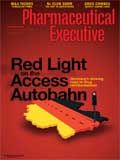Spotlight on OTCs
With OTCs challenging traditional approaches to quality, new opportunities are arising to support industry innovation and advance public health.
Over-the-counter medicines (OTCs) occupy an important place in healthcare delivery. Often self-administered, they may be used by consumers without a prescription. A few OTCs begin as prescription medicines approved by FDA. If FDA later approves, the manufacturer may switch to OTC status. Most OTC products, however, were in widespread use prior to the modern regulatory era and were deemed "generally recognized as safe/effective" by FDA, starting and staying as OTCs, using the FDA monograph system as a basis for marketing. Yet, like all drugs, they rely on quality monographs in the official compendia of the United States Pharmacopeia–National Formulary (USP–NF), published by the US Pharmacopeial Convention. These OTCs do not require FDA approval and thus may adapt more quickly to market demands for new dosage forms, combinations, and colors and flavors.

Roger L. Williams
Both OTCs and prescription drugs are subject to the same modern challenges of a globalized industry, including supply chain management/security and the need for rigorous quality control, as active ingredients and finished products increasingly are manufactured outside the US. Both types of medications also are subject to the same consumer expectations for specified efficacy, safety, and quality. This is a point made by Dr. Janet Woodcock, director of FDA's Center for Drug Evaluation and Research (CDER), at a USP workshop on OTC quality held in September. Dr. Woodcock noted that while the FDA OTC monograph system has served all parties well for decades, a serious quality problem could be "catastrophic," not only for consumers but for the system itself. Patient harm is rare and we need to keep it that way, Dr. Woodcock noted.
Drug quality is protected through interwoven, critically important safety nets: a strong regulatory body; ethical manufacturers; and the existence of, and adherence to, private and public standards that help assure the identity, strength, quality, and purity of medicines and their ingredients. Public standards in USP–NF are legally recognized under the Food, Drug, and Cosmetics Act, and manufacturers are required to adhere to them. USP is not an enforcing body—it only creates the standards—but FDA is, and may enforce USP's quality standards. Additionally, USP–NF standards are closely connected in law with GMP standards for drugs.
The challenge for FDA, USP, and OTC manufacturers—and for consumers—is that standards can get out of date, and this may be particularly true for OTC products where the offerings continually change. This is also true of the approximately 240 drug substances that may be used in OTC monograph products, most of which are older ingredients made by multiple manufacturers. And it can be true as well for prescription medicines that are more closely regulated.
USP Workshop
At the September USP workshop, Dr. Scott Furness, director of the Division of Nonprescription Regulation Development at FDA, explained the agency's concerns in more detail, noting that because FDA OTC monograph drugs undergo no pre-market approval, no individual assessment of quality is performed for those drug products also having a USP monograph. Manufacturers assess quality through conformance to the monographs in USP–NF—making the USP monograph even more critical. Furness emphasized that OTC monograph drug products cannot afford to lag behind the quality regulatory standards required for prescription drugs. He also said that one cannot have a safe product that is not also a quality product—the two "go hand in hand." Furness indicated that this is not just a "theoretical concern;" FDA has found OTC products with high levels of impurities that would not be acceptable in a prescription drug.
Modernization
Together, FDA, USP, and industry are working to modernize USP's monograph standards. There are many benefits here, including: strengthening public standards, increasing consistency of monographs, moving from non-specific to specific procedures, and helping to guard against economically motivated adulteration. Practical benefits for industry include removing non-value-added tests and requirements for hard-to-find, outdated equipment. Because USP standards are used by all manufacturers marketing products in the US, they create a level playing field for the ultimate protection of the consumer.
Under an FDA Modernization Task Force formed in 2010, FDA is assisting USP in prioritizing standards for modernization, using a scientific and risk-based approach. This effort is coupled with USP's own criteria for when a monograph needs updating. In 2011, FDA provided USP with an initial list of OTC priorities, focusing first on acetaminophen and diphenhydramine, as well as a number of inactive ingredients. Acetaminophen drug products rise in concern because of widespread use and lack of control of an impurity (p-aminophenol) potentially damaging to kidneys. FDA later provided USP with a second group of drug substances, some of which are used in OTC monograph products. USP has begun work on updating these standards, along with many others previously identified by USP.
Challenges
USP–NF contains more than 4,500 individual quality standards. These all require updating over time, but keeping pace with OTC monograph medicines is particularly challenging, given that manufacturers may introduce new dosage forms, new combinations, and new colors and flavors to meet consumer preferences without submitting an application to FDA and/or providing information and materials to assure an up-to-date USP monograph. There are 37 individual quality monographs for acetaminophen alone in the USP–NF, for example. How to approach updates comprehensively given the sheer volume of monographs is a key question. OTC formulations themselves pose challenges when considering new approaches to standards-setting, particularly those involving products with multiple active ingredients (e.g., cough and cold products) as well as inactive ingredients. USP faces fundamental challenges to modernizing OTC monographs that are best addressed through industry involvement, especially in obtaining updated procedures from manufacturers. The pace of modernization is directly linked to the availability of procedures with allied reference materials.
New Approaches
For the most part, USP modifies a drug substance monograph based on information and materials submitted from a pharmaceutical manufacturer. But manufacturers may have little incentive to do this, particularly for old OTC drug substance monographs made by multiple manufacturers. Increasingly though, USP is finding that it can create such monographs in its own laboratories. If this approach is allied to current practices, USP believes that the process might be accelerated to update the several hundred OTC drug substances used in OTC monograph products.
Responding to the challenge posed by the large number of continually changing monograph dosage forms, USP is seeking new approaches as well. Some of these may include increased reliance on USP general chapters. Many of these general chapters speak across a broad grouping of OTC medicinal products. When this is the case, a general chapter consolidating assay and impurity procedures for acetaminophen products, for instance, would be more efficient than updating 37 individual monographs. Furthermore, such a general chapter would give manufacturers more flexibility to create new OTC monograph medicines—so long as they adhered to the overall stipulations of the general chapter. One central consideration is just how broad the general chapter can be. For pseudoephedrine, as an example, there could be a class general chapter for pseudoephedrine products; at a broader level, for oral nasal decongestants; at a broader level still, for cough, cold, allergy, bronchodilator, and anti-asthmatic products; and at the broadest level, for all products with an oral route of administration. How broad the general chapter could go while still retaining the important value that a public standard provides must be determined—the necessary intersection of flexibility, specific quality attributes, and the enforceability of USP standards. Beyond this "granularity" issue lies the practical need for regulatory enforceability. For a class general chapter, USP might promote industry compliance and FDA enforcement through a "pointer" in USP–NF's General Notices that alludes to the general chapter without a monograph—except perhaps for its name. USP hopes to engage regulators and industry through various public forums to consider this opportunity.
The Three-legged Stool
Underscoring these activities is the critical need for a partnership. At a high level, this is occurring through USP's work not only with FDA but also with the Consumer Healthcare Products Association (CHPA). As noted earlier, a key form of participation is manufacturer donation of procedures. As all will be required to comply once a standard becomes official, the donating manufacturer will have the opportunity to have the public standard based on its in-house standard. To assure broad acceptability, other manufacturers should review and comment on USP proposals for new or revised monographs in the Pharmacopeial Forum. Working together, FDA, USP, and CHPA have engaged in a dynamic collaboration to create a win-win for all—and particularly the consumer of OTC monograph medicines.
Roger L. Williams, MD, is the Chief Executive Officer of the U.S. Pharmacopeial Convention

FDA Grants Priority Review to Regeneron’s Eylea for Macular Edema Following Retinal Vein Occlusion
April 18th 2025Regulatory action was based on data from the Phase III QUASAR trial, which demonstrated that Eylea HD dosed every eight weeks achieved non-inferior visual acuity outcomes compared to Eylea in patients with macular edema following retinal vein occlusion.
Navigating Distrust: Pharma in the Age of Social Media
February 18th 2025Ian Baer, Founder and CEO of Sooth, discusses how the growing distrust in social media will impact industry marketing strategies and the relationships between pharmaceutical companies and the patients they aim to serve. He also explains dark social, how to combat misinformation, closing the trust gap, and more.